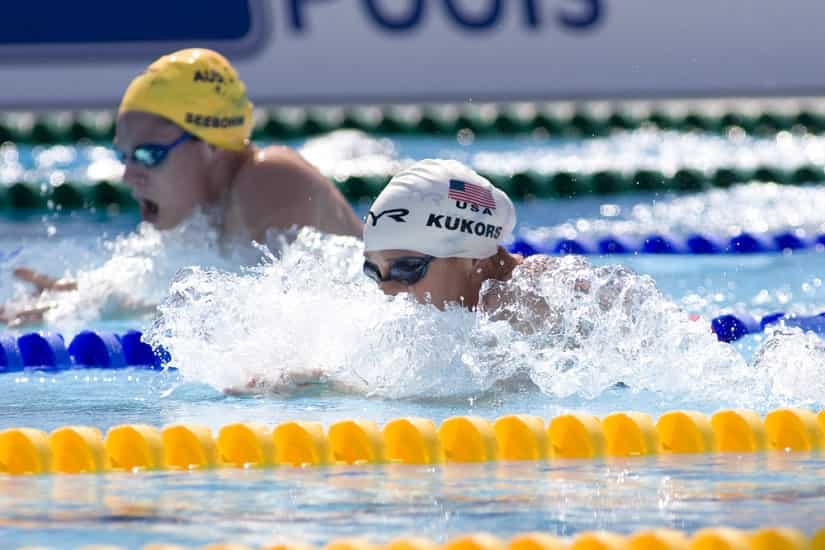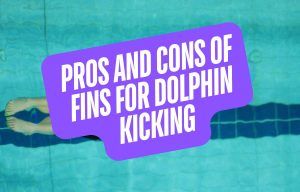Breaststroker’s knee is one of the most common injuries swimmers face. Here’s your battle-plan to fix and prevent breaststroker’s knee.
In this powerhouse guide on how to fix & prevent breaststroker’s knee, and with the help of two world class physiotherapists, we are going to cover it all:
- The research and science behind how common the injury is with swimmers
- You’ll get a better understanding of why and when this specific type of injury happens
- A detailed list of things you can do to keep your knee healthy from the beginning of the season straight till championship season
- And what to do when you do count yourself as injured.
Let’s do this!
 The Research on Breaststroker’s Knee
The Research on Breaststroker’s Knee
Because it is such a frequent injury, there is no shortage of research on knee injuries in swimmers.
Here is what the white lab coats have to offer on how common breaststroker’s knee really is among competitive swimmers:
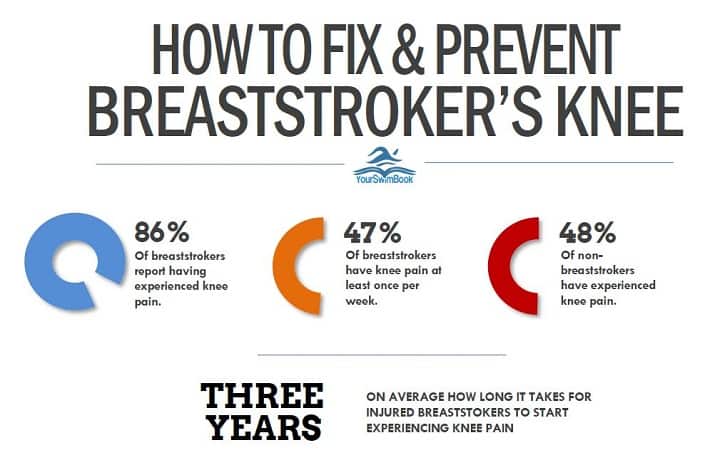
STUDY 1
One study took a group of 18 breaststrokers suffering from knee pain ranging in age from tadpole (6 years old) to 30 years of age.
Pain in the knee started from an early age, typically within three years of starting breaststroke (reinforcing a need to swim with proper fundamentals from an early age).
At first pain was only experienced when the kick was performed, but eventually the pain spread to other athletic and nonathletic activities.
The experienced breaststrokers, 8 years plus, suffered from patellofemoral osteoarthritis (arthritis of the knee), causing pain in the front of the knee that makes it painful to climb stairs or kneel.
STUDY 2
36 breaststroke specialists were surveyed and a full 86% of them had suffered knee pain on at least once, while 47.2% experienced pain in their knee regularly (at least once a week—ouch).
Those who experienced pain more often had less internal rotation in their hips, increased training volume of breaststroke, and decreased warm-up.
Researchers suggested that swimmers should increase breaststroke-specific volume slowly at the beginning of the year and that warm-up should be increased.
STUDY 3
A larger study of nearly 400 swimmers found that a high number of breaststrokers (73%) and even non-breaststrokers (48%) had experienced pain in their knees at some point. Injury rates were highly affected by age and how many years they’d spent training.
A subgroup of 21 swimmers was further examined and found that injury was significantly more likely among swimmers when hip abduction was less than 37 degrees of higher than 42 degrees.
The authors concluded that reducing breaststroke-specific volume and improving the angle of hip abduction at the beginning of the breaststroke kick could help to reduce stress in the knee.
*
So, the research tells us something pretty obvious (especially if you Googled “how to fix breaststroker’s knee” and landed here because your own knee is causing you pain), this is a very prevalent issue with breaststrokers and even non-breaststroke specialists.
“Those that train for the individual medley and others who train the breaststroke still develop pain and disability,” says Keenan Robinson, two-time athletic trainer for the United States Olympic Swim Team, and newly-minted National Team High-Performance Director for USA Swimming.
Robinson has worked with two of the great American individual medley swimmers of recent times—Rio 400m IM silver medalist Chase Kalisz and 200m gold medalist Michael Phelps.
But why is it happening to me, you might be thinking.
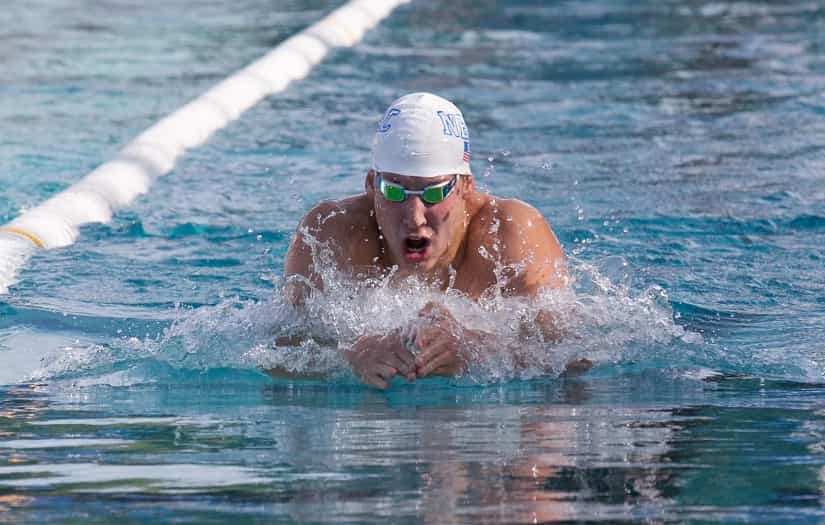
There are a couple of different reasons your knee is acting the fool, Robinson says.
“The first area to look at is the hip joint, decreased hip internal rotation and limited hip extension have been proven to be causative factors in medial knee pain. The limited movement in the hip joint forces the surrounding structures of the knee and ankle to pick up the missing pieces and causes unnecessary wear and tear on the soft tissue entities of the lower extremities.”
And secondly:
“The other major factor in medial knee dysfunction is patellar tracking. Although seen more prevalently in adolescent females, it can be seen in any population. Generally speaking, the knee cap demonstrates abnormal movement, and causes inflammatory properties in the undersurface of the knee cap or surrounding ligaments.”
Okay, so that was a lot of sciencey words to throw at you.
Here’s what you need to know about avoiding this type of injury altogether.
How to Prevent Breaststroker’s Knee
As with any other kind of injury, an ounce of prevention is worth a chlorinated ton of misery later down the road.
Here are some of the key methods to make sure that you are staying ahead of the injury curve:
1. Warm-Up Properly.
Yeah, I know, the thought of having to thoroughly warm-up isn’t always that appealing, especially when we are in a rush to get the workout completed.
For some coaches it’s like pulling teeth to get their swimmers in the water on time and to complete the swimming warm-up. Or worse case the swimmers should up late on deck and miss the warm-up entirely.
However, there are very real reasons not to skip your warm-up, as evidenced by one of the studies mentioned above that linked less warm-up to increased injury rates.
It’s tempting to want to jump straight into the main set with gusto, and while I applaud the enthusiasm, taking the time to warm yourself up properly means that those joints and muscles are better prepared for the punishment to come.
2. Strength Training & Dryland.
Did you know that your dryland exists as more than just to help you appear look great in the mirror?
(True story.)
One of the main reasons swimmers spend time in the gym isn’t just to be able to exert more power in the pool, but also to stabilize. Your time in the gym helps you get stronger, and thereby ward off injury, especially in your knees.
See also: 6 Best Tech Suits for Breaststrokers
“Body weight movements can help enhance musculature surrounding the knee and hip,” says Robinson.
Some of the exercises that he suggests include:
- Lunges (front, reverse, lateral, and diagonal).
- Step ups and step downs (front and side).
- Hip hinge movements (Good mornings)
- Hip thrust
- Glute bridge
- Romanian dead lifts
- Hip abduction
- Eccentric bilateral squats
3. Stretching and mobility.
Your coach has probably tried to drill this into you a million times over the course of your swimming career–being flexible and having a good degree of mobility is important.
Although the temptation is to start doing knee stretches when we want to avoid or fix problems there, the problems usually begin upstream in your hips.
“Good preventative exercises start not with the knee but with the hips,” says Adam Carter, a physiotherapist with Star Physical Therapy who regularly works with swimmers at the Nashville Aquatic Club.
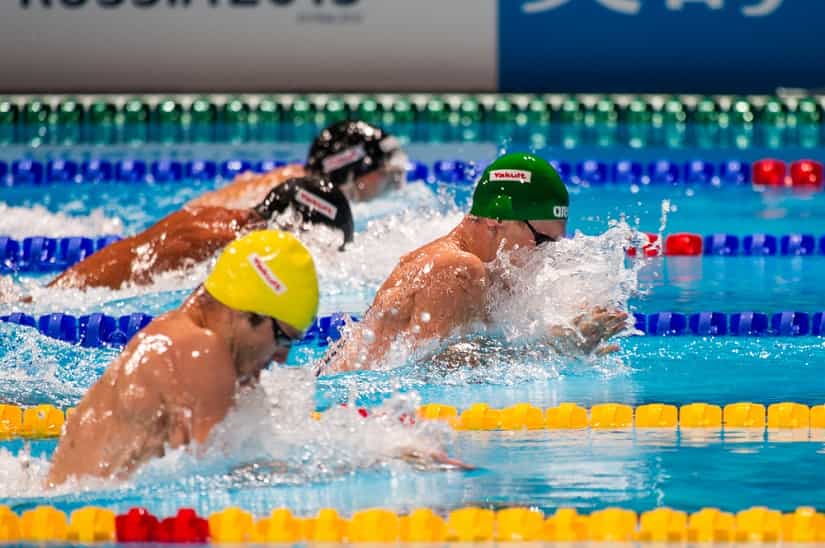
“Groin and piriformis stretching along with hip stability exercises are key to creating the balance between strength and flexibility needed for improved form.”
Robinson, who for years worked alongside swimmers at the North Baltimore Aquatic Club and the University of Michigan, notes how important it is to place an emphasis on mobility from an early age.
Foam rolling is one way to do it.
“Use a foam roller or massage stick to increase blood flow and therefore tissue extensibility in the groin, hip flexor and hip external rotators prior to activity,” he says.
Another is performing mobility and movement prep both on land and in the water.
“They will help to maintain the joint range of motion the athlete already has and prime the movement pattern of the impending activity, which in this case is breaststroke,” adds Robinson.
How to Fix Breaststroker’s Knee
There are three things that you should be doing the moment that you feel the slip of injury set in.
1. Communicate early.
Like most people, I imagine that you are pretty stubborn. You probably pushed your knee further than you should have, out of a hope that maybe the pain would just go away on its own (denial is a wonderful thing…ha).
Having the humility to give yourself permission to seek treatment is key in reducing the severity and frequency of injury.
“Good communication and early intervention are the best ways to decrease the incidence of breaststroker’s knee,” notes Carter.
2. Recognize good pain vs. bad pain.
As athletes were instructed to challenge ourselves. To push our limits. And to ignore that tinny voice in our mind that wants us to give up in the middle of an exceptionally challenging set.
But sometimes, that voice is telling you something accurate and critical.
Again, it’s about being willing to accept that pushing through pain isn’t going to get us anywhere in the long term. Sure, it might make us feel resilient and tough in the moment, but if we end up sidelined for two weeks what was the point?
“Make sure to take quality rest, i.e. activities that don’t aggravate the symptoms,” adds Carter.
3. Have a plan moving forward.
When you feel the onset of breaststroker’s knee it’s tempting to withdraw, shut-down, and accept the situation “as is.”
Instead, take charge of your recovery and gain a sense of doing something about getting healthy by first seeking consultation with your family physician for a complete evaluation.
Next:
“Meet with a certified athletic trainer who can use modalities to control pain and inflammation and give rehabilitation exercises,” says Robinson. “Finally, the swimmer and coach should work hand and hand in a systematic plan to return to full time training.”
The Takeaway
Being injured sucks. Completely. I get it. I’ve been there too.
But the way you handle things now, how resilient you are in the face of adversity, and how you come back from injury will define your performance in the water, not the injury.
Need proof?
Research on a wide array of super champions found that resilience was the key defining characteristic of how successful they were. Their determination to use adversity as rocket fuel for future performances (“I’m going to make this the best to ever happen to me”) was what set them apart mentally from the competition.
Additionally, other research found that mental training skills (goal setting, good self-talk, etc.) were vastly underused with even elite athletes when they were injured.
Which leaves an opening for you to make the most of a bad situation and springboard back into your swimming full-speed and with a clear, focused mind.
See Also:
Swimmer’s Shoulder: Everything You Need to Know About Fixing and Preventing It. With the help of Olympians, physiotherapists, and even a space scientist we break down how to get back in the pool after incurring swimmer’s shoulder.
The Psychological Toll of Being Injured All the Time. Chronic injury isn’t just hard on your body and training, but it is also draining mentally. Here is how to keep yourself motivated in the face of injury.
6 Tips for How to Swim Faster Breaststroke. Some of the titans in breaststroke swimming and coaching share their tried and proven tips for swimming faster breaststroke.

